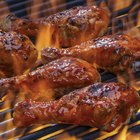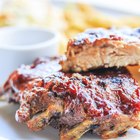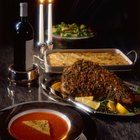Ake Dynamic/iStock/GettyImages
Almost any decent charcoal grill can be used to smoke old-school barbecued meats, but learning to provide stable indirect heat can take some time. A better tool for the job is an offset smoker, which moves the bed of coals to a separate enclosure and then vents smoke into the cooking chamber. The best smokers use a reverse flow system, which guides the hot air and smoke to the far end of the cooking chamber before letting it return to the chimney. This provides more even heat, and better cooking.
Prepare and season your meats ahead of time. Trim excess fat and connective tissue from brisket or pork shoulder, and remove the tough membrane from the back of your racks of ribs. Rub the meats with your favorite spice paste or dry rub, and refrigerate them overnight if you wish.
Light charcoal in your smoker's firebox, using a medium- to large-sized chimney starter. Purists prefer lump charcoal, though briquettes also work well and can provide both longer and more predictable heat. Add a few small pieces of hardwood if you want a more intense smoke flavor.
Position a digital thermometer at each end of the cooking chamber, with the probes inside the chamber and the displays visible on the side work areas. Offset smokers can vary in temperature from one end of the chamber to the other, even reverse flow models, so it's important to know where your cooker is hotter than you'd like.
Adjust the cooker's sliding vents until you can maintain a stable temperature of approximately 225 degrees Fahrenheit inside the cooker. This is suitable for almost any form of barbecue, including brisket, ribs and pulled pork. Place your meat on the cooking chamber's rack, and close the lid.
Slow-cook the meats until they're fork-tender. This typically takes 2.5 to 3.5 hours for back ribs, and four to five hours for spare ribs, with pork shoulders and briskets sometimes needing 12 to 14 hours. Refill the firebox as needed with hot charcoal throughout the cooking time, starting the coals in your chimney starter and then transferring them to the firebox once they've developed a coat of ash.
Remove the meats from your grill and let them rest for five to 15 minutes before serving.
Related Articles

How to Use a Smoker Box for Gas Grilling

How to Use an Offset Smoker to Cook a ...

How to Use Wood Chips in a Smoker

How to Light a Propane Barbecue Grill

How to Smoke a Sirloin Tip Roast

The Best Ways to Grill Brats
How to Cook Prime Rib on an Electric ...

How to Cook Pork Ribs on a Propane Grill
How do I Cook a Prime Rib on an Open ...

How to Barbecue Roast Beef

Cooking Times for Smoking Meat in an ...

How to Cook Chicken in a Crockpot & ...

How to Use Camp Chef Smoke Vault

How to Cook Marinated Pork Loin From a ...

How to Cook With an Infrared Burner on ...

How to Smoke Pork on a Gas Grill

How to Smoke a Leg of Lamb Using an ...

How to Use a Weber Gas Grill: First ...

How to Cook Steaks on a Smoker

How to Make a Cheap Smoker
References
Tips
- Use only a bare minimum of hardwood to generate smoke. Using too much can fill the meat with harsh flavors, and it's a novice's mistake.
- Good-quality smokers are made of heavy duty metal and have tight-fitting doors to prevent heat and smoke from escaping. If your smoker leaks while it's cooking, purchase a welder's blanket to drape over it. This blocks smoke from escaping, and helps the thin metal retain heat.
- This style of cooking is inherently slow, so be patient. If your meat reaches its "done" temperature but isn't fork-tender, let it cook for another hour or two. The bonds between the muscle fibers in the meat will eventually relax and the connective tissues will melt into natural gelatin, producing rich and tender barbecued meats.
Writer Bio
Fred Decker is a trained chef and prolific freelance writer. In previous careers, he sold insurance and mutual funds, and was a longtime retailer. He was educated at Memorial University of Newfoundland and the Northern Alberta Institute of Technology. His articles have appeared on numerous home and garden sites including GoneOutdoors, TheNest and eHow.